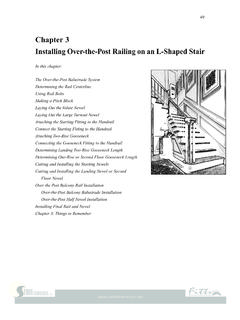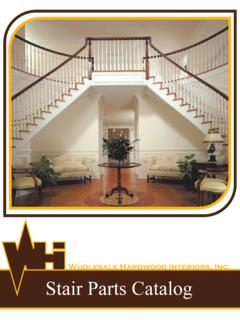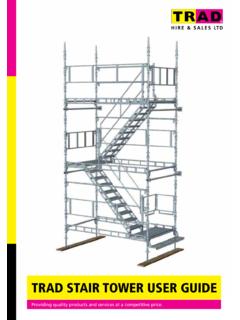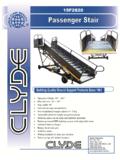Transcription of Chapter 5 Installing Balusters
1 Chapter 5 Installing BalustersIn this Chapter :Stair BalustersTread-oriented BalustersInstalling Square Top BalustersLaying Out the TreadsBoring the TreadsCutting the BalustersInstalling the BalustersInstalling Round Top BalustersBoring the TreadsBoring the RailCutting the BalustersInstalling the BalustersRail-oriented or Raking the BalustersInstalling Square Top BalustersInstalling Round Top BalustersInstalling Balcony or Landing BalustersLayout and BoringVolute BalustersLaying Out Volute Balusters Using a Manufacturer Provided TemplateDesigning a Custom Volute Baluster LayoutInstalling Volute BalustersLarge Turnout BalustersLaying Out Turnout Balusters Using a Manufacturer Provided TemplateDesigning a Custom Turnout Baluster
2 LayoutInstalling Turnout BalustersChapter 5: Things to Remember105 TMQuality and Tradition in Every StepStair BalustersBalusters are the narrow, vertical sections of the staircase that help support the handrail. They areoffered in a variety of sizes and designs and are usually selected to achieve aesthetical appeal. Dueto safety reasons, baluster spacing is regulated by local building codes. The two most commontypes of Balusters are square top and taper top. This Chapter will describe two types of baluster installations; tread-oriented baluster installationand rail-oriented baluster and Tradition in Every StepTread-Oriented BalustersOrienting the Balusters to the treads is considered the more traditional installation method.
3 Withthis type of installation, the bottom square on each of the Balusters is the same length. Balustersare therefore oriented to correspond to the tread. Please note Fig. 5-1 Tread OrientedRail OrientedTMQuality and Tradition in Every Step107 Fig. 5-1 Traditional Tread OrientitationInstalling Square Top BalustersLaying Out the TreadsIn the previous chapters you learned that when you set the newels and rail, you established a balusteror rail centerline for the staircase. You will use this centerline to determine the placement of the balus-ters on the treads. The face of the front or first baluster is usually even with the face of the riser. The following steps describe the process:1. From the face of the riser, measure back half the width of the baluster you are using and placea mark intersecting it with the rail centerline.
4 2. Space the second baluster evenly on the tread, so that all the Balusters , up the rake (slope) arethe same distance apart. On a two baluster per step installation, this is achieved by dividingthe run of the stair by two. (This is the distance between adjacent risers.) Then measure backfrom the center mark of the first baluster and place a mark that intersects with the rail center-line. This will be the center mark of the second baluster. Please note Fig. 5-2 and Tradition in Every StepRiserRiserRun1/2 runFig. 5-2 Determining placement of Balusters on treads for two baluster per step runFig. 5-3 Determining placement of Balusters on treads for three baluster per step the three baluster per step installation the placement is calculated the same way, except youmust take the run and divide by three.
5 Please note Fig. 5-3 : Most building codes dictate that baluster placement must not allow a 4-inch sphere to passthrough it. Consult local building codes for exact the Treads1. When Installing manufactured Balusters , drill the tread to accept the pre-made pins on the bottom of the baluster. If a factory turned dowel is not available, there are two basic types ofdowels that may be added to your baluster: the wood dowel and the metal baluster install a wood dowel, drill a 1-inch hole in the bottom of the baluster (taking special care tomatch the correct diameter) and insert the dowel into the baluster. The dowel should be gluedinto the hole with at least 1/2-inch extending out from the bottom of the baluster.
6 Note: The dowel should be large enough to withstand the structural second dowel type is a double-ended dowel screw. (Dowel screws and dowel screwdriverscan be purchased through your local stair parts distributor.) Dowel screws are utilized by insert-ing one end into the bottom of the baluster and leaving half of the screw exposed to insert intothe and Tradition in Every StepDrill ChuckDriver(Comes with kit)FastenerBalusterF3003 Baluster Fastener (No Driver)F3009 BalusterFastener DriverNote: This dowel should be large enough to withstand the structural requirements. 4. Scribe a line even with the pitch of the rail. 5. Add the depth of the plow in the bottom of the rail to this Using a miter-saw, cut the baluster at the proper the Balusters1.
7 Place a small amount of glue into the hole in the tread and push the bottom dowel of the baluster firmly into the hole. 2. Next, place a small drop of glue on the top of the baluster and slide the angle cut of the baluster into the plowed portion of the On the previously marked intersecting lines of the baluster, drill a hole about 1-inch deep witha brad point bit of the appropriate diameter. Make sure the hole is perpendicular to the top ofthe the Balusters1. Measure the length of every baluster in place. 2. Hold the baluster in place with the dowel pushed firmly into the hole in the Use a level to plumb the baluster perfectly. Please note Fig.
8 5-4 and Tradition in Every StepFig. 5-4 Cutting the square top line3. Fasten the baluster to the rail with two small nails. 4. Use fillet to fill the plow between the Balusters . 5. Measure the distance between the Balusters and cut the fillet with the proper angles on each end. 6. Place two drops of glue on the bottom of the fillet and push it firmly into the plow. 7. Secure it with two small Round Top BalustersBoring the TreadsThe instructions for this procedure are identical to the installation of square top Balusters . Pleasenote the prior the Rail1. Using a level or a plumb bob, make a mark on the bottom of the rail directly above and corre-sponding with the baluster center on the tread.
9 2. Drill a hole of the appropriate diameter in the bottom of the rail. The hole size is determined bythe diameter of the baluster top you have chosen. Note: This hole must be drilled are several ways to bore the hole. One method is to use a jig made with a pitch block (seeinstructions in Chapter 3 on making a pitch block).111 TMQuality and Tradition in Every StepTMQuality and Tradition in Every StepDrill a hole perpendicular to the run. The hole must be accurate and is best done on a drill presswith the run side flat on the table. The drill bit should be the exact diameter of the baluster hole will guide your drill. Please note Fig. 5-5 Next, clamp the jig to the bottom of the rail with the run side parallel with the treads and the jighole centered with the baluster mark on the bottom of the Drill the holes in the bottom of the rail about 1-1/2-inch deep.
10 Place a piece of tape on the drillbit to make the holes uniform in depth and to prevent drilling too deep. Cutting and Installing the Balusters1. Measure the length of every baluster in Hold the baluster in place with the dowel pushed firmly into the hole in the tread. 3. Line the center of the top of the baluster with the center of the hole in the bottom of the rail. 112 TMQuality and Tradition in Every StepFig. 5-5 Using a jig to drill holes on a hole perpendicular to runClamp to railanddrill holeTMQuality and Tradition in Every StepRail-oriented or Raking the BalustersThe term "rail - oriented" generally applies to a baluster installation in which the bottom squareand turning of the baluster is parallel to the handrail and not the tread.






